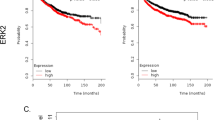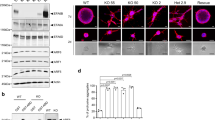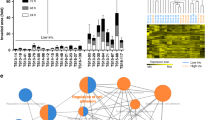Abstract
Inter-patient and intra-tumoral heterogeneity complicate the identification of predictive biomarkers and effective treatments for basal triple negative breast cancer (b-TNBC). Invasion is the initiating event in metastasis and can occur by both collective and single-cell mechanisms. We cultured primary organoids from a b-TNBC genetically engineered mouse model in 3D collagen gels to characterize their invasive behavior. We observed that organoids from the same tumor presented different phenotypes that we classified as non-invasive, collective and disseminative. To identify molecular regulators driving these invasive phenotypes, we developed a workflow to isolate individual organoids from the collagen gels based on invasive morphology and perform RNA sequencing. We next tested the requirement of differentially regulated genes for invasion using shRNA knock-down. Strikingly, KRAS was required for both collective and disseminative phenotypes. We then performed a drug screen targeting signaling nodes upstream and downstream of KRAS. We found that inhibition of EGFR, MAPK/ERK, or PI3K/AKT signaling reduced invasion. Of these, ERK inhibition was striking for its ability to potently inhibit collective invasion and dissemination. We conclude that different cancer cells in the same b-TNBC tumor can express different metastatic molecular programs and identified KRAS and ERK as essential regulators of collective and single cell dissemination.
This is a preview of subscription content, access via your institution
Access options
Subscribe to this journal
Receive 50 print issues and online access
$259.00 per year
only $5.18 per issue
Buy this article
- Purchase on Springer Link
- Instant access to full article PDF
Prices may be subject to local taxes which are calculated during checkout




Similar content being viewed by others
Data availability
The RNA-seq data discussed in this publication have been deposited in NCBI’s Gene Expression Omnibus [28] and are accessible through GEO Series accession number GSE215069 (https://www.ncbi.nlm.nih.gov/geo/query/acc.cgi?acc=GSE215069). Additional requests for information or data will be fulfilled by the corresponding author upon request.
References
Marra A, Trapani D, Viale G, Criscitiello C, Curigliano G. Practical classification of triple-negative breast cancer: intratumoral heterogeneity, mechanisms of drug resistance, and novel therapies. npj Breast Cancer. 2020;6:1–16.
Prat A, Adamo B, Cheang MCU, Anders CK, Carey LA, Perou CM. Molecular Characterization of Basal-Like and Non-Basal-Like Triple-Negative Breast Cancer. Oncologist. 2013;18:123–33.
Friedl P, Wolf K. Plasticity of cell migration: A multiscale tuning model. J Cell Biol. 2010;188:11–9.
Te Boekhorst V, Preziosi L, Friedl P. Plasticity of Cell Migration in Vivo and in Silico. Annu Rev Cell Dev Biol. 2016;32:491–526.
Yamada KM, Sixt M. Mechanisms of 3D cell migration. Nat Rev Mol Cell Biol. 2019;20:738–52.
Casasent AK, Schalck A, Gao R, Sei E, Long A, Pangburn W, et al. Multiclonal Invasion in Breast Tumors Identified by Topographic Single Cell Sequencing. Cell 2018;172:205–17.
Aw Yong KM, Ulintz PJ, Caceres S, Cheng X, Bao L, Wu Z, et al. Heterogeneity at the invasion front of triple negative breast cancer cells. Sci Rep. 2020;10:1–10.
Westcott JM, Prechtl AM, Maine EA, Dang TT, Esparza MA, Sun H, et al. An epigenetically distinct breast cancer cell subpopulation promotes collective invasion. J Clin Invest. 2015;125:1927–43.
Padmanaban V, Tsehay Y, Cheung KJ, Ewald AJ, Bader JS. Between-tumor and within-tumor heterogeneity in invasive potential. PLoS Comput Biol. 2020;16:1–27.
Pfefferle AD, Herschkowitz JI, Usary J, Harrell JC, Spike BT, Adams JR, et al. Transcriptomic classification of genetically engineered mouse models of breast cancer identifies human subtype counterparts. Genome Biol. 2013;14.
Maroulakou IG, Anver M, Garrett L, Green JE. Prostate and mammary adenocarcinoma in transgenic mice carrying a rat C3(1) simian virus 40 large tumor antigen fusion gene. Proc Natl Acad Sci USA. 1994;91:11236–40.
Padmanaban V, Grasset EM, Neumann NM, Fraser AK, Henriet E, Matsui W, et al. Organotypic culture assays for murine and human primary and metastatic-site tumors. Nat Protoc. 2020;15:2413–42.
Jang MH, Kim HJ, Kim EJ, Chung YR, Park SY. Expression of epithelial-mesenchymal transition-related markers in triple-negative breast cancer: ZEB1 as a potential biomarker for poor clinical outcome. Hum Pathol. 2015;46:1267–74.
Grasset EM, Dunworth M, Sharma G, Loth M, Tandurella J, Cimino-Mathews A, et al. Triple-negative breast cancer metastasis involves complex epithelial-mesenchymal transition dynamics and requires vimentin. Sci Transl Med. 2022;14.
Hanley CJ, Henriet E, Sirka OK, Thomas GJ, Ewald AJ. Tumor-resident stromal cells promote breast cancer invasion through regulation of the basal phenotype. Mol Cancer Res. 2020;18:1615–22.
Cheung KJ, Gabrielson E, Werb Z, Ewald AJ. Collective invasion in breast cancer requires a conserved basal epithelial program. Cell 2013;155:1639–51.
Cheung KJ, Padmanaban V, Silvestri V, Schipper K, Cohen JD, Fairchild AN, et al. Polyclonal breast cancer metastases arise from collective dissemination of keratin 14-expressing tumor cell clusters. Proc Natl Acad Sci USA. 2016;113:E854–63.
Padmanaban V, Krol I, Suhail Y, Szczerba BM, Aceto N, Bader JS, et al. E-cadherin is required for metastasis in multiple models of breast cancer. Nature 2019;573:439–44.
Kim RK, Suh Y, Yoo KC, Cui YH, Kim H, Kim MJ, et al. Activation of KRAS promotes the mesenchymal features of Basal-type breast cancer. Exp Mol Med. 2015;47.
Merz V, Gaule M, Zecchetto C, Cavaliere A, Casalino S, Pesoni C, et al. Targeting KRAS: The Elephant in the Room of Epithelial Cancers. Front Oncol. 2021;11:1–16.
Giltnane JM, Balko JM. Rationale for targeting the Ras/MAPK pathway in triple-negative breast cancer. Disco Med. 2014;17:275–83.
Koboldt DC, Fulton RS, McLellan MD, Schmidt H, Kalicki-Veizer J, McMichael JF, et al. Comprehensive molecular portraits of human breast tumours. Nature 2012;490:61–70.
El Guerrab A, Bamdad M, Kwiatkowski F, Bignon YJ, Penault-Llorca F, Aubel C. Anti-EGFR monoclonal antibodies and EGFR tyrosine kinase inhibitors as combination therapy for triple-negative breast cancer. Oncotarget 2016;7:73618–37.
Muzumdar MD, Tasic B, Miyamichi K, Li L, Luo L. A global double-fluorescent Cre reporter mouse. Genesis 2007;45:593–605.
Kim D, Paggi JM, Park C, Bennett C, Salzberg SL. Graph-based genome alignment and genotyping with HISAT2 and HISAT-genotype. Nat Biotechnol. 2019;37:907–15.
Putri GH, Anders S, Pyl PT, Pimanda JE, Zanini F Analysing high-throughput sequencing data in Python with HTSeq 2.0. 2021;(March):1–3.
Love MI, Huber W, Anders S. Moderated estimation of fold change and dispersion for RNA-seq data with DESeq2. Genome Biol. 2014;15:1–21.
Edgar R, Domrachev M, Lash AE. Gene Expression Omnibus: NCBI gene expression and hybridization array data repository. Nucleic Acids Res. 2002;30:207–10. https://doi.org/10.1093/nar/30.1.207.
Acknowledgements
We thank all members of the Ewald Laboratory for critical discussions. AJE received support for this project through grants from: the Breast Cancer Research Foundation (BCRF-21-048), Twisted Pink Foundation, Hope Scarves, the Cindy Rosencrans Fund for Triple Negative Breast Cancer Research, the Jayne Koskinas Ted Giovanis (JKTG) Foundation, METAvivor Foundation, and the National Institutes of Health / National Cancer Institute (U01CA217846, U54CA268083, 3P30CA006973). JSB receives support from: the Jayne Koskinas Ted Giovanis (JKTG) Foundation and the National Institutes of Health / National Cancer Institute (U01CA217846).
Author information
Authors and Affiliations
Contributions
EH and AJE conceptualized the project and designed the experiments. EH performed most of the experiments. HK and JSB performed RNA-seq data analysis. EMG performed the in vivo experiments. MD contributed to qPCR data collection and analysis. MH was in charge of maintaining the mouse colony. EH and AJE wrote the manuscript with useful inputs from all authors.
Corresponding author
Ethics declarations
Competing interests
AJE has unlicensed patents and patent applications related to the use of K14 as a prognostic biomarker, to the use of antibodies in cancer treatment, and to 3D culture protocols for tumor organoids. AJE’s spouse is an employee of Immunocore. JSB is a founder of Neochromosome and consultant for its parent company Opentrons Labworks Inc and serves on the SAB of Reflexion Pharmaceuticals. The other authors declare no competing interests.
Additional information
Publisher’s note Springer Nature remains neutral with regard to jurisdictional claims in published maps and institutional affiliations.
Rights and permissions
Springer Nature or its licensor (e.g. a society or other partner) holds exclusive rights to this article under a publishing agreement with the author(s) or other rightsholder(s); author self-archiving of the accepted manuscript version of this article is solely governed by the terms of such publishing agreement and applicable law.
About this article
Cite this article
Henriet, E., Knutsdottir, H., Grasset, E.M. et al. Triple negative breast tumors contain heterogeneous cancer cells expressing distinct KRAS-dependent collective and disseminative invasion programs. Oncogene 42, 737–747 (2023). https://doi.org/10.1038/s41388-022-02586-2
Received:
Revised:
Accepted:
Published:
Issue Date:
DOI: https://doi.org/10.1038/s41388-022-02586-2



